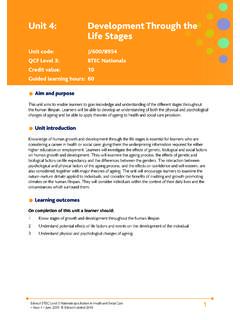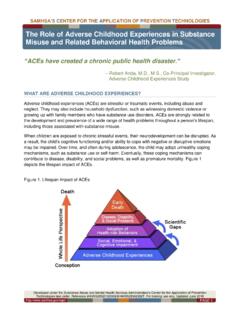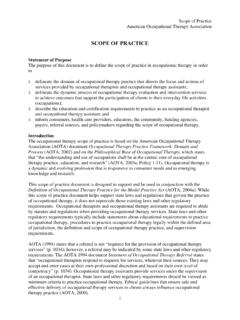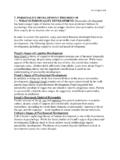Transcription of Chapter 11: Adolescence: Physical and Cognitive Development
1 Chapter 11: Adolescence: Physical and Cognitive DevelopmentDevelopment Across the LifespanWhat Physical changes do adolescents experience?Adolescence is a time of considerable Physical and psychological growth and change!ADOLESCENCEis the developmental stage between childhood and age at which adolescence begins and ends is imprecise, partly because society is unclear about the roles of people in this stage (no longer children, not yet adults)The Rapid Pace of Growth During AdolescenceExtreme changes in height and weight are commonTermed the adolescent growth spurt a period of rapid growth changes in height and weightThe rate of growth matches the high growth rate of infancyOn average, boys grow inches in height each year, girls inchesGirls begin their growth spurts earlier (aprox. 2 years) and complete them earlierBy age 13, boys are taller on averageGrowth PatternsPatterns of growth pictured two ways: The first figure shows height at a given age, while the second shows the increase that occurs from birth through the end of the teen years.
2 Notice the differences in growth between boys & growth spurt around age 12, girls around 10 Puberty: The Start of Sexual MaturationPUBERTY is the period when sexual organs mature, beginning earlier for girls than for begin puberty about 11 or 12; boys begin at 13 or 14. Sexual MaturationThe changes in sexual maturation that occur for males and females during early triggers puberty?No one has identified the reason that it begins when it does!Environmental & cultural factors play a role in age of puberty. MENARCHE,the onset of menstruation,varies in different parts of the world and even with affluence levels. More affluent, better nourished, healthier girls start menstruation earlier. Menarche age in the US has declined since 19th of MenstruationThe onset of menstruation occurs earlier in more economically advantaged countries & in more affluent environments.
3 Why is this the case?The Development of PRIMARY SEX CHARACTERISTICS involves organs and structures of the body related to SEX CHARACTERISTICS involve the visible signs of sexual maturity that do not involve sex organs directlyTable in text summarizes sexual maturationBody Image: Reactions to Physical Changes in AdolescenceBody Image involves an adolescent's own reactions to these Physical changes. Western society's views of menarche have become more positive than they used to be so girls tend to have higher self-esteem and self-awareness when they begin menstruating. Boys first ejaculation is roughly equivalent to girls menarche, but it is rarely discussed (and less anxiety provoking than menarche).The Timing of PubertyThe timing of puberty is a key factor for how adolescents react to it. Early maturation is generally positive for boys.
4 Early maturing boys tend to be better at athletics, be more popular, have more positive self-esteem, and grow up to be more cooperative and responsible. On the other hand, these boys also are more likely to have school difficulties and become more involved The Timing of Puberty, continuedEarly maturation is often difficult for girls. Early maturing girls tend to be more popular but they may not be ready to deal with dating situations. Reactions depend on cultural norms (country and community).The Timing of Puberty, continuedLate maturation is difficult for boys. Smaller boys are seen as less attractive and have a disadvantage in sports. These difficulties often lead to declines in self-concept which can extend into adulthoodThe Timing of Puberty, continuedFor late maturing girls the picture is complicated.
5 Late maturing girls can be overlooked and have low social status at first. However, when they catch up their self-esteem is highNutrition, Food & Eating Disorders During AdolescenceFood and eating disorders become a focus during adolescence. The adolescent growth spurt requires an increase in food (especially key nutrients such as calcium and iron). Several key nutrients are essential during this period, especially calcium and ironThe major nutritional issue for many teens: eating a balance of appropriate foods(Nutrition, Food & Eating Disorders During Adolescence, continued)Obesity is a common concern during adolescence. The psychological consequences of adolescent obesity are severe since while body image is a key focus. Potential health consequences of obesity are also of concern(Nutrition, Food & Eating Disorders During Adolescence, continued)ANOREXIA NERVOSAis a severe eating disorder in which individuals refuse to eat, while denying that their behavior and appearance, which may become skeletal, are out of the ordinary.
6 This disorder primarily affects white women. These women are often intelligent, successful, attractive, and from affluent homes(Nutrition, Food & Eating Disorders During Adolescence, continued)BULIMIAis an eating disorder characterized by binges on large quantities of food, followed by purges of the food through vomiting or the use of laxatives. A chemical imbalance results from constant vomiting or diarrhea. This can have serious effects, including heart failure(Nutrition, Food & Eating Disorders During Adolescence, continued)Eating disorders are products of both biological and environmental causes so treatment involves multiple techniquesDietary modificationsStress managementCognitive Development increases markedly during adolescence!~Teens begin to use formal operations to solve problems during this period of their s approach to Cognitive Development has had a significant influence on developmental OPERATIONS PERIODis the stage during which people develop the ability to think abstractly.
7 Piaget asserted that children enter this stage at the beginning of adolescencePiaget s approachto Cognitive Development , continuedFull capabilities of using principles of logic unfold gradually, throughout early adolescence (approximately ages 12 to 15). Not everyone achieves formal operational skills (some studies estimate that 25 percent 50 % of college students do not). Social values/ culture also influence the achievement of these skillsIsolation, level of formal education, level of scientific sophistication in the community Criticisms of Piaget's theory and approach. Research finds individual differences in Cognitive abilities not universal. Some researchers suggest that Cognitive Development is more continuous, less step-like than Piaget proposed. Piaget underestimated the skills of infants and young children.
8 Piaget focused only on thinking and knowing, missing other kinds of Processing Approaches to Cognitive DevelopmentUnlike Piaget s view that Cognitive advances occur in stage-like spurts, information processing theorists emphasize gradual and continuous growth!The INFORMATION-PROCESSING PERSPECTIVE sees changes in Cognitive abilities as gradual transformations in the way that individuals take in, use, and store information. From this view, thinking advances during adolescence result from the ways people organize their thinking and develop new strategies. Information Processing Approaches to Cognitive Development , continuedInformation Processing Perspectives assert that one of the key reasons that mental abilities advance during adolescence is the growth of metacognitionThe growth of METACOGNITION, the ability to think about one's own thinking process and their ability to monitor their in Adolescent ThinkingADOLESCENT EGOCENTRISM is a stage of self-absorption where the world is seen only from one's own perspective.
9 Thus adolescents are highly critical of authority figures, unwilling to accept criticism, and quick to find fault with others. Adolescent egocentrism helps explain why teens often think they re the focus of everyone s attention!Developmental Psychologist David Elkind argues that the adolescent period fosters adolescent egocentrismAdolescent egocentrism leads to two distortions: IMAGINARY AUDIENCE,where adolescents think they are the focus of everyone else's attention. Constructing elaborate scenarios about other s thoughts/intentionsPERSONAL FABLES,the belief that the adolescent is unique and exceptional and shared by no one elseNo one understands meRisk taking behaviorSchool Performance in the Adolescent YearsWhile Cognitive abilities increase, school performance tends to decline. Reasons not completely clear more strict grading?
10 There is a strong relationship between educational achievement and socioeconomic status (SES) Poorer children have fewer resources, lower health, more inadequate schools, and less involved parents. High School Graduation RatesThe reasons for the drop in rates are likely related to a combination of factors, including the growing diversity of had high graduation rates, but those rates are dropping compared to other industrialized nations. (School Performance in the Adolescent Years, continued)A controversial theory (The Bell Curve) identifies genetics as the source of this SES-achievement correlation. The differences in educational achievement start from the beginning of school with the gap widening throughout the are ethnic and racial differences in school achievement but the reason for them is not clear.







